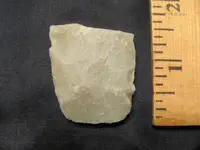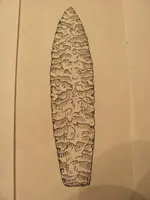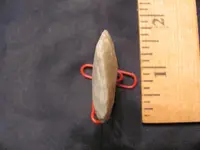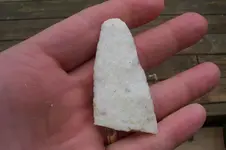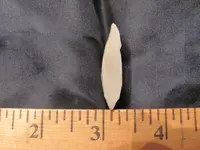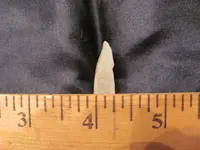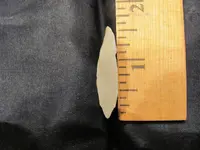You are using an out of date browser. It may not display this or other websites correctly.
You should upgrade or use an alternative browser.
You should upgrade or use an alternative browser.
Could It Be? Need Your Opinions.
- Thread starter old digger
- Start date
NC field hunter
Silver Member
I'm with Sohio. To me, it doesn't seem to taper down as thin as an agate basin. However, I can not say honestly that I have seen an agate basin in real life. Only pics. As Sohio said above, the agate basin ( in pictures anyway) have small reduction flakes all over. The base here has larger flakes than I would think an agate basin would have. My word is soooo far from the gospel though.
N
natchitoches
Guest
it looks a little to flat for a Agate Basin
could we get side pictures?
could we get side pictures?
old digger
Gold Member
- #6
Thread Owner
I forgot the photo of base showing the base grinding. New photo above.
old digger
Gold Member
- #7
Thread Owner
Thank You for your suggestions.
11KBP
Hero Member
I found this piece on saturday also. It sure looks like the base of an Agate Basin. The base and edges are ground and the shape is there.
How thick is this piece? The last pic you posted gives it the appearance of being at least 3/8 inches thick.
Neanderthal
Bronze Member
If it was broken during reduction stages (which looks highly likely), than the grinding is probably due to edge / platform preparation. In other words, it broke on them while making it. Any knapper will tell you that it's common (usually followed by a few swear words).
old digger
Gold Member
- #10
Thread Owner
old digger
Gold Member
- #11
Thread Owner
If it was broken during reduction stages (which looks highly likely), than the grinding is probably due to edge / platform preparation. In other words, it broke on them while making it. Any knapper will tell you that it's common (usually followed by a few swear words).
Thanks Neanderthal! I didn't swear when I found it, but close. I was REALLY disappointed that it was broken. It does look as you said. The knapper was not completely finished when it broke.
11KBP
Hero Member
How thick is this piece? The last pic you posted gives it the appearance of being at least 3/8 inches thick.
It shows a strong 1/4 inch thick
Okay, a strong 1/4" thick is more like it and would be within the
range of the specimens from the Agate Basin type site.
It could be as Neanderthal suggested, broken during reduction.
During the reduction process I was under the impression grinding
a location was done just previous to the next flake removal. So,
not being a knapper I am wondering if it was a common practice
to grind all three surfaces, (the base and both basal edges) all
at one time before proceeding with the reduction sequence.
I believe you stated all three of those surfaces were ground.
Neanderthal
Bronze Member
Okay, a strong 1/4" thick is more like it and would be within the
range of the specimens from the Agate Basin type site.
It could be as Neanderthal suggested, broken during reduction.
During the reduction process I was under the impression grinding
a location was done just previous to the next flake removal. So,
not being a knapper I am wondering if it was a common practice
to grind all three surfaces, (the base and both basal edges) all
at one time before proceeding with the reduction sequence.
I believe you stated all three of those surfaces were ground.
In initial cobbling and reduction stages you always have to focus on deltas and isolate those platforms, but when they get to this stage it's quicker (for me at least) to abrade the whole side, sometimes around the whole perimeter before whacking. It just makes things a little more speedy and efficient when you have an abraded, consistent edge to work with. I have a few aboriginal pieces that have the whole distal end or a side abraded, I assume it's due to resharpening preparation.
I know some knappers who abrade the piss out of everything (even the faces) before running a row of flakes, almost to the point of being FOG. I've also noticed some aboriginal knappers practiced that as well, I have seen several (especially to the east) Clovis points that exhibit heaving grinding / abrading on the face.
Last edited:
old digger
Gold Member
- #15
Thread Owner
In initial cobbling and reduction stages you always have to focus on deltas and isolate those platforms, but when they get to this stage it's quicker (for me at least) to abrade the whole side, sometimes around the whole perimeter before whacking. It just makes things a little more speedy and efficient when you have an abraded, consistent edge to work with. I have a few aboriginal pieces that have the whole distal end or a side abraded, I assume it's due to resharpening preparation.
I know some knappers who abrade the piss out of everything (even the faces) before running a row of flakes, almost to the point of being FOG. I've also noticed some aboriginal knappers practiced that as well, I have seen several (especially to the east) Clovis points that exhibit heaving grinding / abrading on the face.
Your analysis and opinion makes a lot of sense. If you look at the piece as it lays flat, you can imagine seeing what the piece would look like with the finishing touches added. Again Thanks for your input.
Here are two more that I have found that are quite similar. hese have a more pronounced grinding on the bases, and also show better lateral flaking.
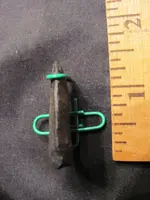
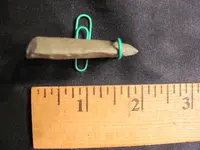

Last edited:
Similar threads
- Replies
- 5
- Views
- 482
- Replies
- 7
- Views
- 789
- Suggestion
- Replies
- 13
- Views
- 945
Users who are viewing this thread
Total: 1 (members: 0, guests: 1)

